Kia Optima Hybrid: Evaporative Emission Control System / Schematic Diagrams
| Schematic Diagram |
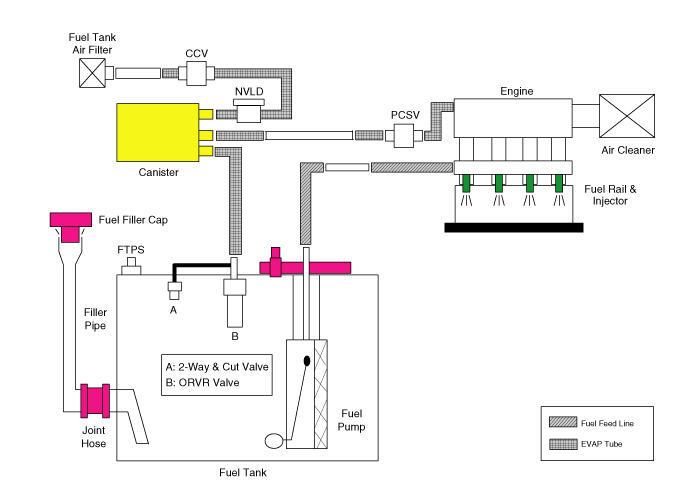
Canister
The Canister is filled with charcoal and absorbs evaporated
fuel vapor from the fuel tank. The gathered fuel vapor in canister is
drawn into the intake manifold by the ECM/PCM when appropriate
conditions are set.
Purge Control Solenoid Valve (PCSV)
The Purge Control Solenoid Valve (PCSV) is installed in the
passage connecting the canister to the intake manifold. It is a duty
type solenoid valve and is operated by ECM/PCM signal.
To draw the absorbed vapor into the intake manifold, the ECM/PCM will open the PCSV, otherwise the passage remains closed.
Fuel Filler Cap
A ratchet tightening device in the threaded fuel filler cap
reduces the chances of incorrect installation, when sealing the fuel
filler. After the gasket on the fuel filler cap and the fill neck flange
make contact, the ratchet produces a loud clicking noise indicating the
seal has been set.
Fuel Tank Pressure Sensor (FTPS)
The Fuel Tank Pressure Sensor (FTPS) is an integral part of
the monitoring system. The FTPS checks Purge Control Solenoid Valve
(PCSV) operation and leaks in the Evaporative Emission Control System by
monitoring pressure and vacuum level in the fuel tank during PCSV
operating cycles.
Canister Close Valve (CCV)
The Canister Close Valve (CCV) is located between the
canister and the fuel tank air filter. It closes off the air inlet to
the canister for the Evaporative Emissions System and also prevents fuel
vapors from escaping from the Canister when the vehicle is not
operating.
NVLD (Natural Vacuum Leakage Detection)
NVLD (Natural Vacuum Leakage Detection) module is located
between the canister and the fuel tank air filter. The NVLD is to detect
leaks equivalent to a 0.5 mm hole in the fuel tank, canister and hoses.
The NVLD module has a pressure switch and a temperature sensor. ECM
monitors the pressure status by the temperature change through the
pressure switch and the temperature sensor and found if there is a leak
or not.
[Normal Diagnosis]
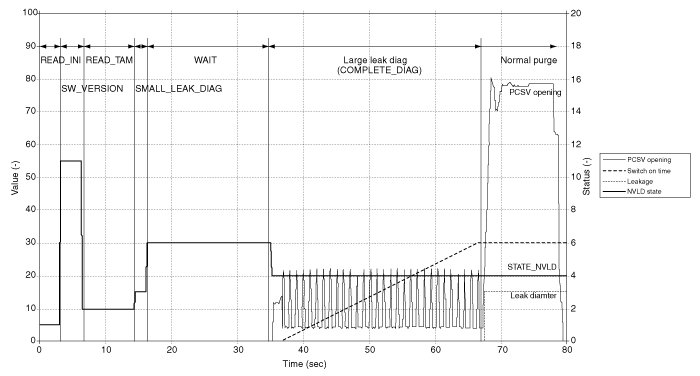
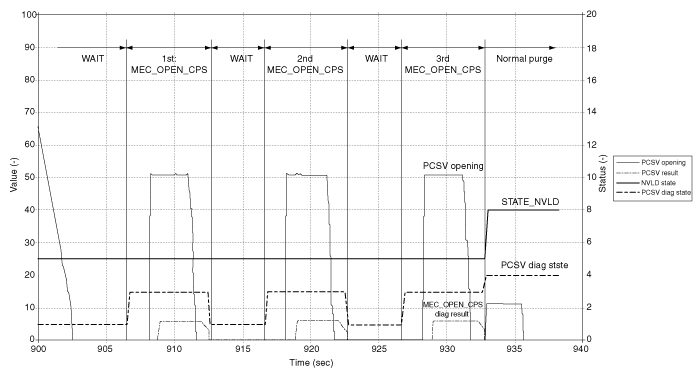
| 1. |
Reading information (READ_INI & INI)
Ready to start diagnosis with initialization. Diagnosis starts with driver''s request of vehicle start (key position at start)
When the process starts, ECM reads the NVLD information & failures which are saved during vehicle key OFF period.
The valid air temperature sensing range is -40°C to 120°C.
An „out of range“ is reported, if the measured temperature is out of
this range. After requesting, the memorized values from the NVLD are
read. The following information is acquired from the NVLD module; air
temperature 6C deviation for at least 2 hour during soaking, checking
NVLD switch closed during soaking, air temperature sensor plausibility /
electrical failure check, which is detected during soaking, pressure
switch electrical failure check during soaking, and reset failures due
to power loss |
| 2. |
Reading information (SW_VERSION)
NVLD sends the 8 bit software version value when the ECM performs a request. |
| 3. |
Reading Air temperature ( TAM_SWI_DIAG / READ_TAM)
When ECM requests NVLD Air temperature, the measured temperature value is sent to HCU as an 8-bit value.
In case an "out of range" error, maximum or minimum values
are received. During the period, whenever ECM requests NVLD pressure
switch electrical checking, NVLD returns the current and actual values
for the electrical switch error. For the values are red from the NVLD,
it is possible to return more than one electrical error at the same
time, as all errors could have occurred during engine on phase. |
| 4. |
Small leakage diagnosis (SMALL_LEAK_DIAG)
To check small leak, ECM requests the saved information from
NVLD. During soaking, the resolution of switch closed time is 10min.
This means, a maximum time of 2.5h (15 * 10min) can be counted. The
switch closed time is reported to the ECM. |
| 5. |
WAIT
Delay time to wait for the next process |
| 6. |
Large leakage diagnosis (COMPLETE_DIAG)
At this process, ECM checks large leak with checking switch
position. During large leak diagnosis, ECM requests switch position
information which includes the current switch position and the switch
position transition, which has been monitored since engine run. |
| 7. |
PCSV plausibility diagnosis (CPS_CHK)
When Large leak error is detected or switch is closed at the
beginning of engine start, canister purge valve (PCSV) stuck diagnosis
is performed with opening PCSV. |
| 8. |
STOP
When all of diagnosis are finished, ECM requests STOP mode.
During the period, whenever ECM requests NVLD pressure switch electrical
checking, NVLD returns the current and actual values for the electrical
switch error until end of driving cycle. |
| 9. |
ERROR
When any error is detected so EVAP monitoring can not be proceeded, ERROR status is performed. |
| 10. |
OFF
When engine is off with key-off, ECM request STOP status.
NVLD is reactivated with a wake-up call at next driving cycle (key
position at start). During the period, NVLD checks its timer function
and reports error message if any problem is detected. |
| 11. |
SLEEP
If the key OFF monitoring conditions to detect small leak are
not satisfied, ECM requests Sleep status. During the status, no
calculations are done in NVLD during the key OFF period. |
[EVAP Leak Test Diagnosis]
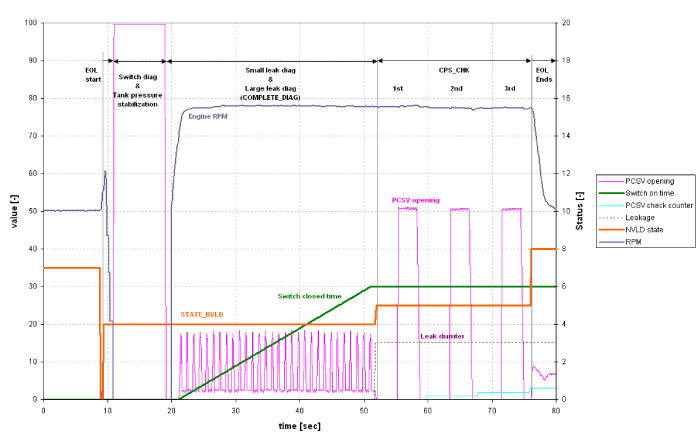
| 1. |
Switch check & Tank pressure stabilization
To perform NVLD Leak Test Diagnosis, ECM software skips the
normal process and starts diagnosis directly after Leak Test Diagnosis
requests. When Leak Test Diagnosis is requested by external tool, ECM
requests HCU to stop engine. When the engine stops, ECM fully opens PCSV
to check NVLD pressure switch stuck failure and to stabilize tank
pressure before starting Leak Test Diagnosis. If any switch stuck
failure is detected, Leak Test Diagnosis ends and reports the results
via tool. |
| 2. |
Small & Large leak diagnosis
After checking switch stuck and pressure stabilization, ECM
requests HCU to run engine and the target idle is 1500rpm for running
stability. ECM opens PSCV and checks NVLD pressure switch position until
the switch is closed. The longer switch closed time is, the bigger leak
size can be estimated. ECM converts the switch closed time into leakage
size and reports the results. If no leakage or small leak is detected,
Leak Test Diagnosis ends. But if large leakage failure is detected, the
process goes to the next step. |
| 3. |
PCSV plausibility diagnosis
When any large leak failure is detected at previous status,
ECM performs PCSV stuck diagnosis to check the root cause to make large
leak. ECM opens PCSV and checks the diagnosis results. If the diagnosis
results are acceptable, ECM finishes Leak Test Diagnosis and confirms
large leakage failure. But if the results are out of range, ECM tries
PCSV plausibility diagnosis max 3 times. When the results are still
unsatisfactory even after 3 trials. ECM confirms PCSV stuck failure and
reports the results. |
| 4. |
Leak Test Diagnosis cancelling
If any conditions are not satisfied, ECM stops the process
and reports the cancel reason via scan tool. An engineer can check the
root cause and solve the problems to cause stop the process. |
Evaporative And ORVR Emission Control System
This system consists of a fill vent valve, fuel shut-off
valve, fuel cut valve (for roll over), two way valve (pressure/vacuum
relief), fuel liquid/vapor separator which is installed beside the
filler pipe, charcoal canister which is mounted under the rear floor LH
side member and protector, tubes and miscellaneous connections.
While refueling, ambient air is drawn into the filler pipe so
as not to emit fuel vapors in the air. The fuel vapor in the tank is
then forced to flow into the canister via the fill vent valve. The fuel
liquid/vapor separator isolates liquid fuel and passes the pure vapor to
the charcoal canister.
While the engine is operating, the trapped vapor in the
canister is drawn into the intake manifold and then into the engine
combustion chamber. Using this purge process, the charcoal canister is
purged and recovers its absorbing capability.
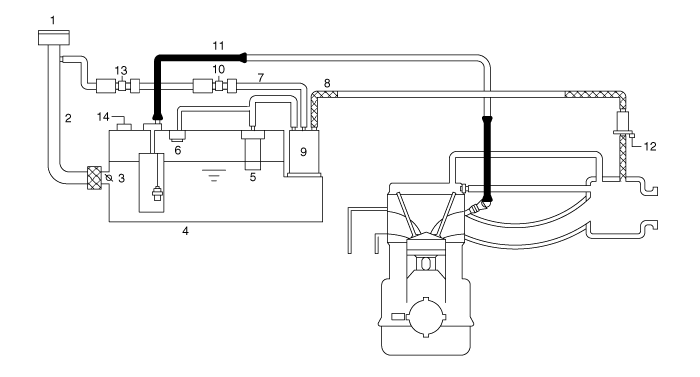
| 1. Fuel Filler Cap 2. Fuel Filler Pipe 3. Fuel Shut-OFF Valve 4. Fuel Tank 5. ORVR Valve 6. 2-Way & Cut Valve 7. Evaporative Hose | 8. Evaporative Hose 9. Canister 10. Natural Vacuum Leakage Detection (NVLD) Module 11. Fuel Feed Line 12. Purge Control Solenoid Valve (PCSV) 13. Canister Close Valve (CCV) 14. Fuel Tank Pressure Sensor (FTPS) |
 Description and Operation
Description and Operation
Description The Evaporative Emission Control System prevents fuel vapor stored in fuel tank from vaporizing into the atmosphere. When the fuel evaporates in the fuel tank, the vapor passes through vent ...
 Repair procedures
Repair procedures
Inspection When the engine is shut off, the pressure change in the fuel tank by the ambient temperature is monitored by NVLD and when the engine is started, ECM judges whether there is a leak or not through ...
Other information:
Kia Optima Hybrid (TF HEV) 2016-2020 Service Manual: Shift Cable Components and Components Location
Components 1. Shift lever assembly3. Shift cable assembly 2. Shift cable retainer? ...
Kia Optima Hybrid (TF HEV) 2016-2020 Service Manual: Components and Components Location
Component Location 1. Rear glass defogger relay (Engine room relay box)2. Rear glass defogger switch (A/C controller)3. Rear glass defogger ...
© 2025 Copyright www.koptimatfhev.com
